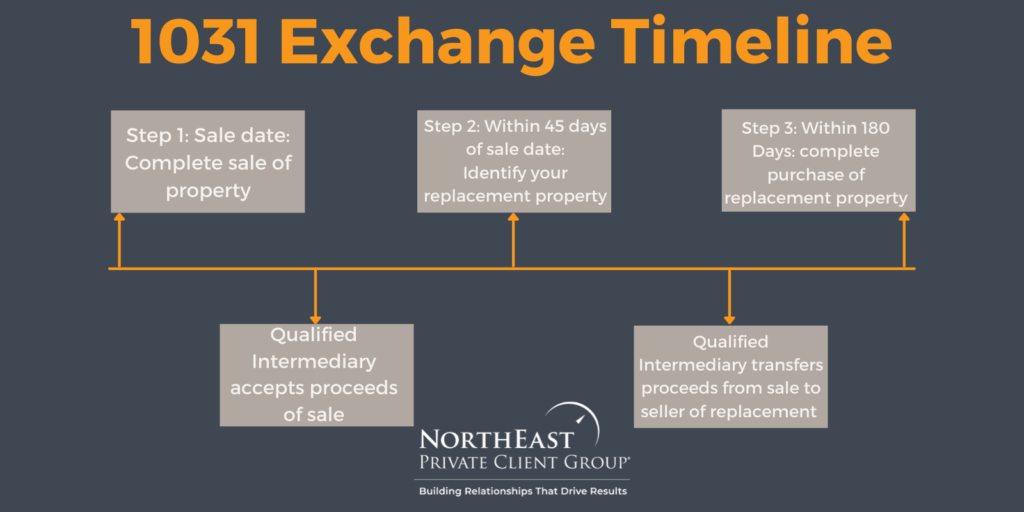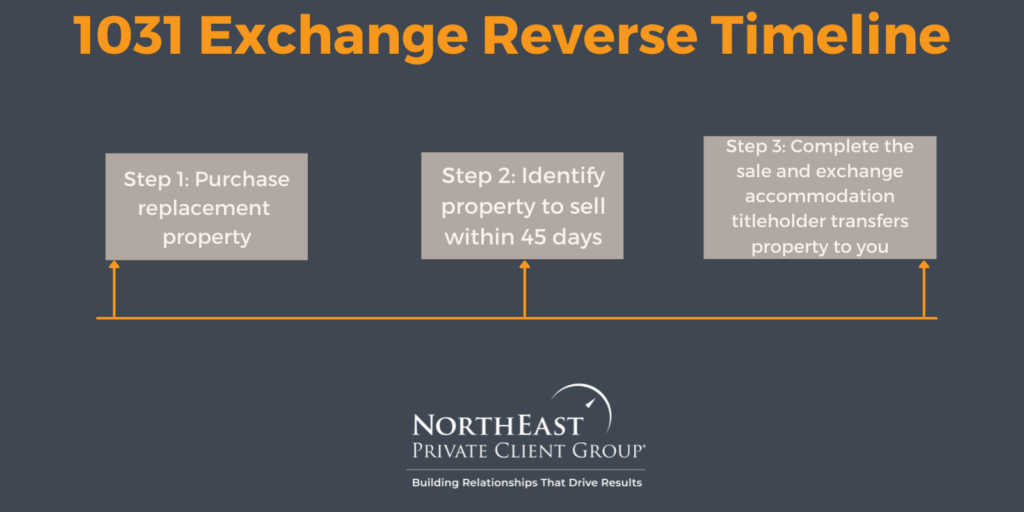As a real estate investor, it’s important to understand what 1031 exchange investment strategies are available to you. It should come as no surprise that with capital gains taxes on the rise, the 1031 exchange is increasingly the preferred strategy for active real estate investors.
Understanding what to expect and how to do a 1031 exchange when it’s time to sell your property can defer capital gains liability allowing you to acquire additional properties with funds that otherwise would have been paid to the IRS. What’s not to love?
Now, before we jump into how to do a 1031 exchange, let’s discuss what a 1031 exchange is.
What is a 1031 Exchange? What are 1031 exchange investment strategies?
A 1031 exchange is a swap of one investment property for another investment property that allows you to postpone paying capital gains taxes. This deferral mechanism only defers capital gain tax when selling an investment property. When the owner sells the replacement property, the previously deferred capital gains tax is recognized.
A 1031 exchange can only take place with like-kind properties. Like-kind refers to the nature of the property. And for this reason, almost all real property is like-kind to each other. This tax law allows your investment to continue to grow tax-deferred.
Tax-deferred 1031 exchange investment strategies are not new – they’ve been available in one form or another since 1921.
In its current form since 1986, a 1031 exchange is a roadmap for selling one qualified property and buying another qualified property within a specific time period. Property to be exchanged must be held for business or investment purposes and not primarily for resale or personal use.
The first step to understanding how to do a 1031 exchange is knowing there are a few major rules and a set of guidelines that you must follow.
Three Major 1031 Exchange Rules in 2021:
- The total purchase price of the new “like-kind” property must be equal to or greater than the total net sales of the sold property.
- All equity received from the sold property must be used to purchase the new “like-kind” property.
- You must step up a 1031 exchange with a QI before the close of the property you’re selling.
Guidelines:
- Both properties must be held for a productive purpose in business or trade as an investment.
- The proceeds from the sale must go through the hands of a qualified intermediary (QI) and not through your broker’s hands or the hands of one of his or her agents or else all the proceeds will become taxable. QIs are companies that work full-time on facilitating 1031 exchanges, and the tax code demands that QIs are independent organizations whose only contact with the exchanger is to serve as a QI.
- The replacement property must be subject to an equal or greater level of debt than the property sold; if not, the buyer will be forced to pay tax on the amount of decrease, and then the buyer will have to put in additional cash to offset the low debt amount on the newly acquired property.
- The period of time in which the new property is received ends exactly 180 days after the date the sold property was transferred — even if this falls on a weekend or holiday — or the due date for the exchanger’s tax return for the taxable year in which the property was transferred, whichever comes earlier.

Benefits of 1031 Exchange Investment Strategies:
We believe that joining a 1031 strategy with commercial real estate offers a roadmap to generational wealth. Other strategies would necessitate paying capital gains tax, which would reduce your buying power by the amount of the capital gains tax, i.e., leaving you only 70-80% of after-tax payments dollars for reinvesting.
Although the logistics are practically the same as any regular sale and buy transaction, a 1031 exchange is unique because the entire transaction is treated not as a sale but as an exchange. The beauty here is that sales are taxable with the IRS, while 1031 exchanges are not. This law is an IRS-recognized approach to the deferral of capital gain taxes.
How to do a 1031 Exchange
There are two different approaches you can take. You can either invest the money into a new property by yourself using a QI and an investment real estate sales firm or you can invest in a group that invests on your behalf.
- Hire a reputable commercial investment real estate brokerage firm: You will want to meet with an advisor to discuss your options and finances to see if a 1031 exchange is the route to go.
- Find a QI: You can find a QI you trust by talking to a reputable investment real estate firm, a real estate attorney, or a CPA with 1031 exchange experience.
- Find a lender for your purchase: Having your financing set up from the start will help you meet the timelines and ensure that your sale and purchase qualify as at 1031 exchange.
- Identify the property you want to sell and provide all paperwork promptly to the investment broker, QI, and the attorney handling the sale.
- Identify the property you want to purchase within 45 days of the original sale
- Close on the property within 180 days
Investing in a Group that Invests on your Behalf for a 1031 Exchange:
According to Fortitude Investment Group:
The Delaware Statutory Trust (DST) and Tenancy in Common (TIC) are the two most common ownership structures for investors who would like to access investment-grade properties together with other accredited investors. Both can qualify as a like-kind interest in real estate for the purposes of a 1031 exchange.
Five parties participate in a DST/TIC offering for a 1031 exchange:
- Sponsor – a real estate firm with experience in acquiring, managing, and divesting commercial properties
- Lender – a major institutional lender
- Attorney – a specialist in 1031 exchanges and real estate transactions
- Broker/Dealer – a FINRA, SIPC member securities brokerage
- Investor – an accredited individual, trust, partnership, LLC, S corporation, and/or C corporation.
There are five steps in a DST/TIC offering:
- Sponsor Due Diligence – The sponsor finds the most attractive investment-grade properties and performs extensive due diligence for each. If satisfied with the results, the sponsor acquires or contracts to purchase the property and the offering is initiated.
- Arrangement for Debt Financing – Once a property for acquisition is identified, the sponsor arranges non-recourse debt financing with a major lender, which performs its own due diligence. The loan is made in whole to the sponsor and is assumed by the investors as a non-recourse loan according to their proportionate share of the offering. Loan repayments are made by the property manager or the asset manager, which is usually the sponsor.
- Preparation of the Private Placement Memorandum – Once the debt is negotiated, the sponsor structures the equity component of the acquisition through a private placement offering. This requires the sponsor to retain legal counsel to write a Private Placement Memorandum (PPM) discloses all risks and material facts related to the offering.
- Signing the Selling Agreement – Once the PPM has been prepared, the PPM and all information used in underwriting the offering is presented to a FINRA member securities broker dealer. The brokerage conducts its own due diligence on the sponsor and the property before signing a selling agreement. This adds another layer of protection for the investor.
- Presentation to Prospective Investor – Once the selling agreement is signed by the broker dealer, its licensed, registered representatives can present it to prospective investors.
1031 Exchange Rules in 2021 on Depreciable Property
There are special rules when depreciable property is exchanged. Depreciable property is any asset that is eligible for tax and accounting purposes. Depreciable property can include real estate except for land (Investopedia).
When a depreciable property is exchanged, it can trigger a profit known as depreciation recapture. Depreciation Recapture is taxed as ordinary income. When you know how to do a 1031 exchange, you can avoid this by swapping one building for another building using a 1031 exchange tax law.
Delayed Exchanges and Timing Rules
When considering a 1031 exchange, it’s important to think about what you’ll be exchanging your current property into. It can be difficult to find a like-kind property for your exchange. For that reason, the majority of 1031 exchanges are delayed. In a delayed 1031 exchange, the QI holds the cash after your property sells. The QI will place the funds in an account until you buy the replacement property. This three-party exchange is considered a swap.
45 Days and 180 Days what do they mean?
Within 45 days of selling your property, you must designate the replacement property in writing to the QI. According to the IRS, you can designate up to three properties and still qualify for the 1031 exchange as long as you close on one of them. But don’t forget you must close on the new property within 180 days of selling the original.
Are you wondering about other 1031 Exchange Investment Strategies?
How to do a 1031 Exchange in Reverse
You can do a reverse 1031 exchange. In this case, you would purchase your replacement property first, have 45 days to identify the property you want to sell, and then have 180 days to sell it.

It is vital to follow the guidelines to gain the benefits of the exchange. That’s where we come in. Our investment real estate teams across the North and Southeastern United States have years of professional experience in the 1031 exchange process.
For more information about 1031 exchanges, visit our blog “1031 Exchanges: On the Chopping Block? Six Things to Know in 2021” for information about the proposed tax laws and changes to the 1031 exchange.


Taylor Hicken |
I do agree when you shared that it’s essential to consider what you’ll be exchanging your current property into when planning to do a 1031 exchange. It is best to hire a reliable service that can help ensure everything is done accordingly. I would like to think if a company needs to do a 1031 exchange, it should consider hiring a reliable service that can help with it.
Kristyn Neal |
Absolutely, anyone doing a 1031 exchange should consider hiring the appropriate service and consulting with their lawyer and/or CPA.
Private Placement Memorandum |
This article breaks down how to do a 1031 exchange and explains the guidelines for potential investors. Thanks for sharing!
Nicole Adams |
You’re welcome, thanks for reading our blog!
Henry Killingsworth |
It was interesting to me when you talked about how a 1031 exchange occurs when you swap one investment property to buy another. With that in mind, would it be a good idea to work with an intermediary when performing a 1031 exchange? Working with an intermediary seems like a good way to make sure both sides of the investment do their part.
Nicole Adams |
Thank you for reading our blog on 1031 exchange. Working with an intermediary when performing a 1031 exchange would be the safest way in my opinion.